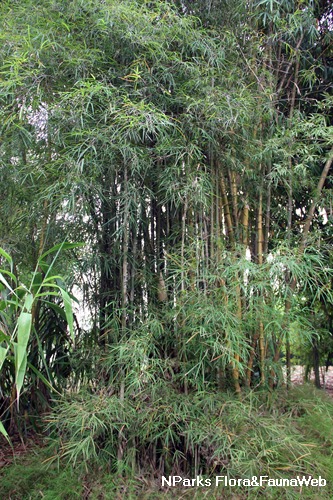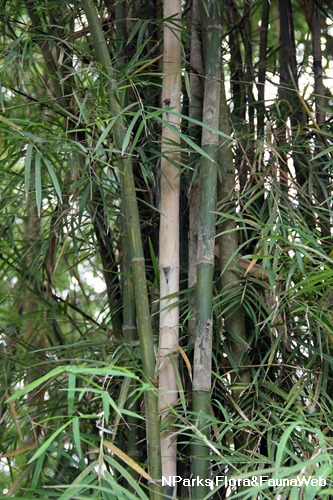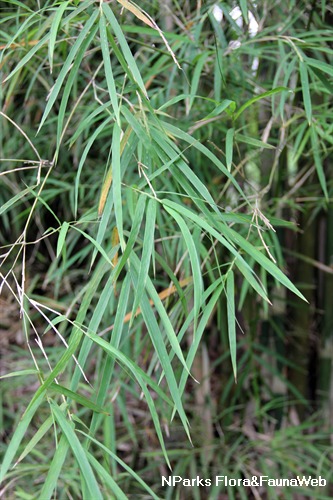
Back
Thyrsostachys siamensis Gamble
| Family Name: | Poaceae (Gramineae) |
| Synonyms: | Bambusa siamensis Kurz ex Munro, Bambusa regia Thomson ex Munro nom. rej., Thyrsostachys regia (Thomson ex Munro) Bennet nom. rej. |
| Common Name: | Monastery Bamboo, Temple Bamboo, Thailand Bamboo, Siamese Bamboo, Umbrella Bamboo, Thai Umbrella Bamboo |
Thyrsostachys siamensis, known as Monastery Bamboo, is a deciduous bamboo that is native to subtropical China and continental Southeast Asia. It has erect, hollow culms up to 5–15 m tall and slender, light-green leaves. This species is often planted in containers at Thai monasteries, which gives rise to the common name.
Name
Classifications and Characteristics
| Plant Division | Angiosperms (Flowering Seed Plants) (Monocotyledon) |
|---|---|
| Plant Growth Form | Grass or Grass-like Plant, Bamboo |
| Lifespan (in Singapore) | Perennial |
| Mode of Nutrition | Autotrophic |
| Plant Shape | Columnar |
| Maximum Height | 7 m to 13 m |
Biogeography
| Native Distribution | South-Central China, Myanmar, Laos, Vietnam, Cambodia, & Thailand |
|---|---|
| Native Habitat | Terrestrial (Monsoon Forest) |
| Preferred Climate Zone | Sub-Tropical / Monsoonal |
| Local Conservation Status | Non-native (Horticultural / Cultivated Only) |
Description and Ethnobotany
| Growth Form | It is an erect, deciduous, clustering bamboo that reaches 5–15 m tall. |
|---|---|
| Foliage | The leaves are narrowly linear, measuring 5–15 cm long × 0.3–0.7 cm wide. The upper surface of the leaf blade is smooth with slightly rough areas near the margins and midrib, while the underside is hairy. The leaf margin is covered in fine hairs. A false petiole is present. The papery, triangular leaf sheath surrounds the lower portion of the internode (part of the stem between two nodes). |
| Stems | The culms (aboveground stems of grasses and grass-like monocots) are smooth and erect, growing up to 1.5–6 cm in diameter. Younger culms are covered in appressed, white hairs. The internode is green, becoming grey-green with a white waxy ring below, and measures 15–30 cm long. Each node (stem joints) holds a cluster of slender branchlets of 5–7 alternately-arranged leaves. Rhizomes (thick, horizontal modified stems) are present, forming a tight clump. |
| Flowers | The flowers are known as florets, and consist of heavily reduced petals and sepals, yellow anthers, and stigmas. The florets are clustered into pseudospikelets, and several of these form a panicle (a type of inflorescence with repeated branching). Flowering occurs unpredictably, sometimes at intervals up to 40 years. |
| Fruit | The fruit is a beaked caryopsis (a type of dry, indehiscent fruit, commonly known as a grain), measuring 0.5–0.8 cm long × 0.3 cm wide. |
| Habitat | It can be found in mixed deciduous forests, occasionally in deciduous dipterocarp forests, at elevations of 70–1,000 m above sea level. |
| Cultivation | This species grows best on fertile, well-drained soil in full sun or semi-shade. However, it is tolerant of nutrient-poor soils. It can be propagated by seed or rhizome division. |
| Etymology | The genus Thyrsostachys is derived from Greek thursos, "stalk" and stachus "spike", referring to the grain-like appearance of the inflorescence. The species epithet siamensis means "from Siam" (now Thailand), referring to this species' country of origin. The common name 'Monastery Bamboo' comes from how often it has bee planted around monasteries in Thailand. Another common name, 'Umbrella Handle Bamboo,' is derived from the culms being used to make umbrella handles, as well as other handicrafts. |
| Ethnobotanical Uses | Food (Fruit or Vegetable): Young shoots are edible, usually added to Asian stir-frys or soups. Others: The culms are used for construction, poles, pulp and paper, furniture, handicrafts, umbrella and broom handles. The pulp can also be used to make paper. |
Landscaping Features
| Landscaping | The narrow leaves of this species are easily rustled by the wind, creating an elegant, peaceful atmosphere. This species is ideal for screening and wind-breaks because it forms erect, tight clumps. A small clump could be planted in gardens for an attractive oriental look. |
|---|---|
| Desirable Plant Features | Ornamental Foliage, Ornamental Stems |
| Landscape Uses | General, Hedge / Screening, Container Planting, Slope Stabilization |
| Thematic Landscaping | Zen / Minimalist Garden |
Fauna, Pollination and Dispersal
| Seed or Spore Dispersal | Abiotic |
|---|
Plant Care and Propagation
| Light Preference | Full Sun, Semi-Shade |
|---|---|
| Water Preference | Moderate Water |
| Plant Growth Rate | Fast to Moderate |
| Rootzone Tolerance | Fertile Loamy Soils, Well-Drained Soils, Poor Infertile Soils |
| Transplanting Tolerance | Moderate |
| Maintenance Requirements | Moderate |
| Pest(s) | Sucking Insects, Chewing Insects |
| Propagation Method | Seed, Division |
Foliar
| Foliage Retention | Deciduous |
|---|---|
| Mature Foliage Colour(s) | Green |
| Mature Foliage Texture(s) | Smooth |
| Foliar Modification | Scale-like |
| Foliar Type | Simple / Unifoliate |
| Foliar Arrangement Along Stem | Alternate |
| Foliar Attachment to Stem | Sessile |
| Foliar Shape(s) | Non-Palm Foliage (Linear) |
| Foliar Venation | Parallel |
| Foliar Margin | Ciliate / Hairy |
| Foliar Apex - Tip | Acuminate |
| Foliar Base | Acute, Cuneate, Truncate / Square |
| Typical Foliar Area | Microphyll ( 2.25cm2 - 20.25 cm2 ) |
Non - Foliar and Storage
| Stem Type & Modification | Cane, Culm |
|---|---|
| Root Type | Underground (Fibrous Root) |
| Specialised Storage Organ(s) | Underground (Rhizome) |
Floral (Angiosperm)
| Flower & Plant Sexuality | Bisexual Flowers |
| Flower Texture(s) | Smooth |
|---|---|
| Flower Grouping | Cluster / Inflorescence |
| Flower Location | Axillary |
| Inflorescence Type | Spikelet / Compound Spike |
Fruit, Seed and Spore
| Fruit Classification | Simple Fruit |
|---|---|
| Fruit Type | Indehiscent Dry Fruit , Caryopsis / Grain |
References
| References | Sungkaew, S., Suddee, S., Wong, K.M., & Teerawatananon, A. (2021). Thyrsostachys (Poaceae: Bambusoideae) in Thailand: taxonomy, lectotypification and natural distribution.Thai Forest Bulletin, BOT. 49(1): 49–56. |
|---|
Image Repository
Others
| Master ID | 30482 |
|---|---|
| Species ID | 4791 |
| Flora Disclaimer | The information in this website has been compiled from reliable sources, such as reference works on medicinal plants. It is not a substitute for medical advice or treatment and NParks does not purport to provide any medical advice. Readers should always consult his/her physician before using or consuming a plant for medicinal purposes. |



